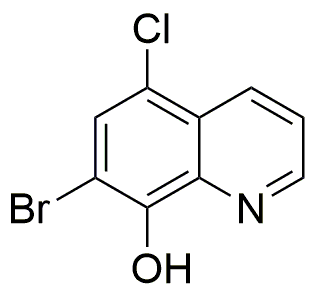7-Bromo-5-chloro-8-hydroxyquinoline is widely utilized in research focused on:
- Antimicrobial Applications: This compound is effective against various bacteria and fungi, making it valuable in developing new antimicrobial agents for pharmaceuticals.
- Analytical Chemistry: It serves as a reagent in analytical techniques, particularly in the detection of metal ions, enhancing the accuracy of environmental testing.
- Pharmaceutical Development: Its unique structure allows for modifications that can lead to new drug candidates, particularly in treating infections and diseases.
- Fluorescent Probes: The compound can be used in creating fluorescent probes for biological imaging, aiding researchers in visualizing cellular processes.
- Research on Metal Complexes: It forms stable complexes with metals, which are essential in studying coordination chemistry and developing catalysts.
Información general
Propiedades
Seguridad y normativas
Aplicaciones
7-Bromo-5-chloro-8-hydroxyquinoline is widely utilized in research focused on:
- Antimicrobial Applications: This compound is effective against various bacteria and fungi, making it valuable in developing new antimicrobial agents for pharmaceuticals.
- Analytical Chemistry: It serves as a reagent in analytical techniques, particularly in the detection of metal ions, enhancing the accuracy of environmental testing.
- Pharmaceutical Development: Its unique structure allows for modifications that can lead to new drug candidates, particularly in treating infections and diseases.
- Fluorescent Probes: The compound can be used in creating fluorescent probes for biological imaging, aiding researchers in visualizing cellular processes.
- Research on Metal Complexes: It forms stable complexes with metals, which are essential in studying coordination chemistry and developing catalysts.
Documentos
Hojas de datos de seguridad (HDS)
La SDS proporciona información de seguridad completa sobre la manipulación, el almacenamiento y la eliminación del producto.
Especificación del producto (PS)
La PS proporciona un desglose completo de las propiedades del producto, incluida la composición química, el estado físico, la pureza y los requisitos de almacenamiento. También detalla los rangos de calidad aceptables y las aplicaciones previstas del producto.
Certificados de análisis (COA)
Busque certificados de análisis (COA) ingresando el número de lote del producto. Los números de lote y de partida se pueden encontrar en la etiqueta de un producto después de las palabras "Lote" o "Lote".
Número de catálogo
Número de lote/lote
Certificados de origen (COO)
Este certificado de origen confirma el país en el que se fabricó el producto y también detalla los materiales y componentes utilizados en él y si se deriva de fuentes naturales, sintéticas u otras fuentes específicas. Este certificado puede ser necesario para cumplir con las normativas aduaneras, comerciales y regulatorias.
Número de catálogo
Número de lote/lote
Hojas de datos de seguridad (HDS)
La SDS proporciona información de seguridad completa sobre la manipulación, el almacenamiento y la eliminación del producto.
DownloadEspecificación del producto (PS)
La PS proporciona un desglose completo de las propiedades del producto, incluida la composición química, el estado físico, la pureza y los requisitos de almacenamiento. También detalla los rangos de calidad aceptables y las aplicaciones previstas del producto.
DownloadCertificados de análisis (COA)
Busque certificados de análisis (COA) ingresando el número de lote del producto. Los números de lote y de partida se pueden encontrar en la etiqueta de un producto después de las palabras "Lote" o "Lote".
Número de catálogo
Número de lote/lote
Certificados de origen (COO)
Este certificado de origen confirma el país en el que se fabricó el producto y también detalla los materiales y componentes utilizados en él y si se deriva de fuentes naturales, sintéticas u otras fuentes específicas. Este certificado puede ser necesario para cumplir con las normativas aduaneras, comerciales y regulatorias.


